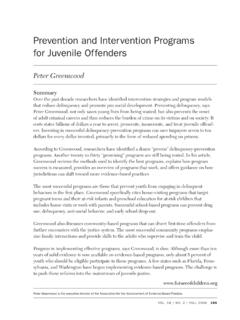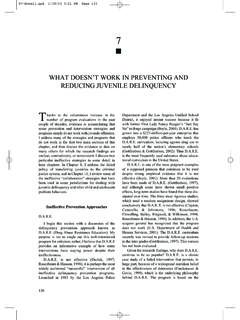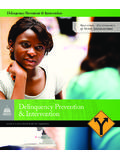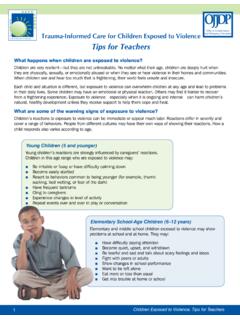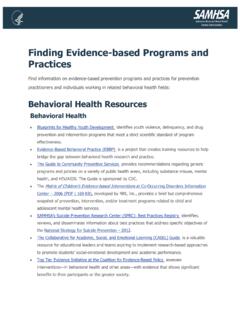Transcription of Preventing Problem Behaviors: Primary, Secondary, and ...
1 JEIBI VOLUME 2, ISSUE NO. 3, Fall, 2005 125 Preventing Problem Behaviors: primary , secondary , and Tertiary Level prevention interventions for young children Tary J. Tobin and George Sugai Abstract The purpose of this report is to compare changes in social skills, Problem behaviors, and academic competence for kindergarten or first grade students identified as being at risk for serious behavior problems who received primary , secondary , or tertiary level preventive interventions .
2 Of the 93 participants in this study, 73% were male; 86% were Caucasian, and 65% were characterized as having externalizing behavior problems. A repeated measures analysis of variance indicated statistically significant differences (p < .01) between the groups based on type of intervention received the Self-Control subscale ( , controlling temper, responding appropriately to teasing) of the Social Skills Rating System (Gresham & Elliott, 1990). School-wide Positive behavior Support is an effective primary prevention intervention, even for young children with serious internalizing or externalizing behavior problems.
3 Key words: Social skills, positive behavior support, self-control, externalizing Problem behaviors, prevention . behavior problems interfere with success in school for many children and create unpleasant situations for teachers and other children . Although traditionally schools often responded reactively to Problem behaviors, with punishments and exclusion, today many educators are seeking to prevent Problem behaviors by using proactive, early interventions . A three-tiered model of prevention , popular in many fields, involves primary , secondary , and tertiary levels of prevention .
4 When Problem behaviors at school are the concern, Positive behavior Support (PBS) is an approach that offers these three levels of prevention (see ). Schoolwide discipline, at the primary prevention level, emphasizes teaching, prompting, and reinforcing appropriate behavior proactively and universally, to all children in the school (Sugai & Horner, 2002). When well implemented, it can be expected to enable most students to behave well in school. Some students may be given additional, support, at the secondary prevention level, if they are considered at risk for Problem behaviors.
5 Decisions about who is at risk may be based on a variety of factors and assessed in different ways. One way of deciding that a child needs some extra behavioral support is simply to notice that the child seems to have some difficulties with peers or in following instructions. In the early elementary grades, teachers often notice behaviors that, while in themselves not particularly severe, might lead to greater problems later, and the teachers may decide to implement some type of early intervention.
6 A more formal way of making this decision is to use a rating scale or other instrument that indicates which children have known risk factors. A few children come to school, from the beginning, with serious behavior problems that are already well established. These children are in need of tertiary level prevention interventions , which are preventive in the sense of Preventing the Problem from getting worse. What evidence supports the use of three levels of preventive interventions in Positive behavior Support in schools?
7 Although the concept is logical, data are needed to show specific effects. In addition, other questions beg for answers: What is the nature of secondary and tertiary level prevention of Problem behavior ? JEIBI VOLUME 2, ISSUE NO. 3, Fall, 2005 126 How does secondary and tertiary level prevention relate to other factors in the educational environmental context? How should the assessment of the effects of behavioral interventions be similar to, and different from, assessment of academic interventions ?
8 Information is needed to clarify the relative effects of primary , secondary , and tertiary prevention level behavioral interventions and to identify unique aspects of applying this approach to behavior problems. A 3-tiered model that works well for changes in academic skills, such as learning to read, may not generalize to situations where resistance to behavioral interventions can only be understood in the relationship to the environmental context. For example, increasing the dosage, or amount, of secondary or tertiary interventions might be related to improved academic outcomes, but not necessarily to behavioral outcomes.
9 One can see how additional instruction in reading would likely lead to improved reading skill. However, additional behavior support typically is related to resistance to intervention (RTI) shown by individuals with chronic and serious behavior challenges. behavior problems, particularly school discipline problems, unlike reading problems, tend to increase in frequency as children get older, at least through elementary and middle school. Across the United States, a number of Centers are developing and testing K-3 behavior and/or Reading Intervention Models, funded by the Office of Special Education Programs (OSEP).
10 Special studies of Tracking Samples ( , students identified as being at high risk of internalizing or externalizing behavior problems) have been added to larger research projects involving three-tiered, school-wide approaches to PBS that have primary , secondary , and tertiary levels of interventions to prevent behavior problems (CCE, 2003). In Oregon, the larger research that provides the foundation for the behavior Tracking Study (BTS) is examination of the Positive behavior Support (PBS) approach ( , Horner, Sugai, Todd, & Lewis-Palmer, 1999-2000; Sugai & Horner, 2002; Sugai, Horner, & Gresham, 2002) in what has come to be known as the 90 Schools Study, or, more formally, as the Research and Demonstration Center on School-Wide behavior Support.










